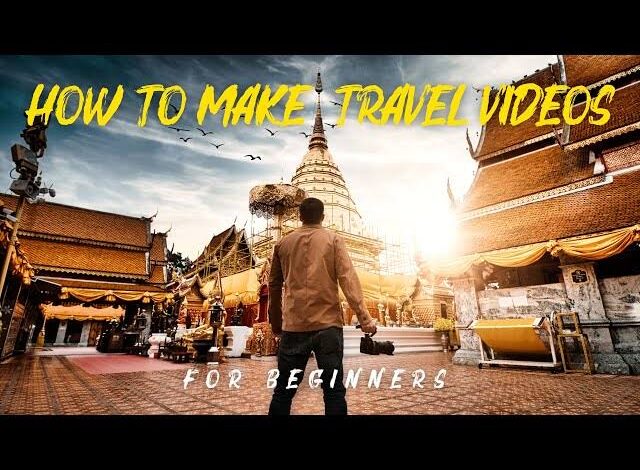How to Film a Travel Video for Your YouTube Channel

Travel videos have become a staple of YouTube content, captivating audiences with stunning visuals, fascinating stories, and unique experiences. Whether you’re an aspiring travel vlogger or an experienced content creator, producing high-quality travel videos can set your channel apart and engage viewers worldwide.
In this guide, we’ll explore the essential steps and tips to help you film an exceptional travel video that stands out on YouTube.
Planning Your Travel Video
Define Your Purpose
Before you even pack your bags, it’s crucial to define the purpose of your travel video. Are you showcasing a particular destination, sharing local experiences, or offering travel tips? Understanding your video’s goal will guide your planning and filming process, ensuring that your content resonates with your audience.
For instance, if you aim to highlight a destination’s cultural aspects, focus on local traditions, festivals, and interactions with residents. If your goal is to provide travel tips, consider including practical advice on navigating the area, must-see attractions, and personal recommendations.
Research Your Destination
Thorough research is the foundation of a successful travel video. Learn about the destination’s key locations, landmarks, and best times to visit. Familiarize yourself with local customs, traditions, and any restrictions or sensitivities you should be aware of. This knowledge will help you plan your shots and ensure respectful and accurate representation.
Consider creating a list of must-visit spots and experiences. This can include iconic landmarks, hidden gems, local eateries, and unique activities. Having a well-researched plan will help you maximize your time and capture the essence of your destination.
Create a Shot List
A shot list is a valuable tool for organizing your filming process. It outlines the essential shots and scenes you want to capture, helping you stay focused and efficient. Include a mix of wide shots to establish the location, close-ups to highlight details, and dynamic angles to add visual interest.
For example, if you’re filming a cityscape, plan for wide shots of the skyline, close-ups of street scenes, and dynamic angles of bustling markets. If you’re showcasing a natural landscape, consider wide shots of the scenery, close-ups of flora and fauna, and aerial shots if possible.
Essential Equipment for Travel Filming
Camera Gear
Selecting the right camera gear is crucial for capturing high-quality footage. While you don’t need the most expensive equipment, having reliable gear will make a significant difference in your video’s production value. Consider using a camera with high resolution and good low-light performance to ensure clear and vibrant visuals.
A versatile camera that offers various shooting modes and settings can help you adapt to different environments and lighting conditions. For instance, a camera with manual controls allows you to adjust settings like aperture, shutter speed, and ISO, giving you greater creative control.
Stabilization Tools
Stabilization tools are essential for smooth and steady footage. Handheld shots can often result in shaky video, which can be distracting for viewers. Using a gimbal, tripod, or stabilizer can help eliminate unwanted camera movement and create professional-looking footage.
A gimbal is particularly useful for capturing smooth moving shots, such as walking through a bustling market or exploring a scenic trail. A tripod is ideal for stationary shots and time-lapses, while a lightweight selfie stick can be handy for vlogging and self-recording.
Audio Equipment
Good audio quality is just as important as high-quality video. Clear audio enhances the viewing experience and ensures that your narration, interviews, and ambient sounds are captured accurately. Consider using an external microphone for better audio quality compared to built-in mics.
A lavalier mic is great for capturing dialogue and interviews, while a shotgun mic can focus on capturing specific sounds from a distance. If you’re filming in windy conditions, use a windshield to reduce wind noise and improve audio clarity.
Lighting Tools
Proper lighting is essential for achieving vibrant and well-lit footage. While natural light can be excellent for travel videos, having portable lighting tools can help you film in low-light conditions or add extra illumination when needed.
Portable lights and reflectors are useful for enhancing your video quality, especially when filming indoors or during overcast days. They can help balance shadows and highlights, making your footage look more polished and professional.
Filming Techniques
Composition Tips
Composition plays a vital role in creating visually appealing travel videos. Applying basic composition principles can help you frame your shots effectively and highlight key elements in your scenes. The rule of thirds is a popular guideline where you divide your frame into a 3×3 grid and place important subjects along the grid lines or at their intersections.
Leading lines can guide viewers’ eyes towards the main subject of your shot, while framing can draw attention to key elements by using natural or architectural elements in the environment. Experiment with different compositions to find the most engaging and aesthetically pleasing arrangements.
Camera Angles
Varying your camera angles can add visual interest and dynamism to your travel video. Wide shots provide context and showcase the location, while close-ups highlight details and create intimacy. Experiment with different angles, such as low-angle shots to emphasize grandeur or high-angle shots to capture expansive views.
Dynamic angles, such as tilting or panning, can add movement and energy to your footage. Incorporate a mix of static and dynamic shots to keep your video engaging and visually diverse.
Movement
Camera movement can enhance the storytelling and create a more immersive experience for viewers. Smooth movements, such as panning and tilting, can capture the flow of a scene and reveal new perspectives. Consider using a gimbal or steadicam to achieve fluid motion and avoid shaky footage.
Tracking shots, where the camera follows a subject or movement, can add a dynamic element to your video. For example, tracking shots of a local market or a scenic trail can convey a sense of exploration and adventure.
B-Roll Footage
B-roll footage, or supplemental footage, is essential for creating a well-rounded and engaging travel video. B-roll can include scenes of local scenery, people, activities, and details that complement your main narrative. It adds depth and context to your video, making it more visually appealing and informative.
Capture a variety of B-roll shots to enrich your video’s story and provide additional visual interest. For instance, if you’re showcasing a cultural festival, include B-roll footage of decorations, performances, and interactions with locals.
Capturing Great Audio
Choosing the Right Microphone
Good audio quality is crucial for conveying your message and enhancing the viewing experience. External microphones generally provide better audio quality than built-in mics, offering clearer and more professional sound.
A lavalier mic is ideal for capturing dialogue, interviews, and narration. It clips onto your clothing and captures sound from a close distance, minimizing background noise. A shotgun mic is designed to pick up sound from a specific direction, making it suitable for capturing distant sounds and reducing ambient noise.
Managing Background Noise
Background noise can be distracting and detract from the quality of your audio. To manage background noise, choose a quiet location for filming whenever possible. If you’re filming in noisy environments, use directional microphones or windshields to minimize unwanted sounds.
When recording interviews or narration, position your microphone close to the speaker and away from noise sources. For outdoor filming, consider using windshields to reduce wind interference and ensure clear audio.
Recording Tips
To achieve the best audio quality, ensure that your recording levels are set appropriately. Avoid recording at extremely high or low levels, as this can result in distortion or low-volume audio. Use headphones to monitor audio in real-time and make adjustments as needed.
Consider recording audio separately and syncing it with your video during the editing process. This can help achieve cleaner and more consistent sound, especially in challenging recording conditions.
Editing Your Travel Video
Selecting Software
Choosing the right editing software is essential for creating a polished and professional travel video video. There are various editing tools available, each offering different features and capabilities. Look for software that allows you to edit video clips, add transitions, adjust colors, and incorporate audio. Additionally, an online YouTube video maker can be particularly useful for quick and convenient video creation.
Editing software should also support a range of file formats and provide options for exporting your video in high quality. User-friendly interfaces and efficient workflows can make the editing process more streamlined and enjoyable.
Editing Techniques
Effective editing enhances your video’s narrative and visual appeal. Start by organizing your footage and creating a rough cut, focusing on the main scenes and key moments. Trim excess footage, arrange clips in a logical sequence, and add transitions to smooth the flow between scenes.
Color grading can enhance the visual quality of your video, adjusting brightness, contrast, and color balance to create a cohesive look. Apply color corrections to ensure consistent color tones throughout your video and highlight key elements.
Adding Music and Sound Effects
Music and sound effects can significantly enhance the mood and atmosphere of your travel video. Choose music tracks that complement the tone of your video and enhance the storytelling. Avoid using copyrighted music without permission; instead, use royalty-free tracks or licensed music to avoid potential issues.
Sound effects can add realism and immersion to your video, such as ambient sounds of a bustling market or the rustling of leaves. Incorporate sound effects subtly to enhance the viewing experience without overwhelming the primary audio.
Incorporating Text and Graphics
Adding text and graphics can provide additional information and context to your video. Use titles, subtitles, and captions to introduce locations, provide explanations, and highlight key points. Ensure that text is clear, readable, and well-integrated into your video’s design.
Graphics such as maps, itineraries, and location tags can help viewers follow your journey and understand the context of your footage. Use graphics sparingly and ensure they enhance the content rather than distract from it.
Optimizing Your Travel Video for YouTube
SEO for YouTube
Optimizing your video for YouTube’s search algorithm can increase its visibility and reach. Start by conducting keyword research to identify relevant terms and phrases related to your travel content. Include these keywords in your video title, description, and tags to improve searchability.
Craft a compelling video title that accurately reflects the content and includes primary keywords. Write a detailed description that provides context, highlights key moments, and includes additional keywords. Use tags to categorize your video and help YouTube understand its content.
Thumbnail Creation
A captivating thumbnail can attract viewers and encourage them to click on your video. Design a visually appealing thumbnail that represents the content and entices viewers to watch. Use high-resolution images, bold text, and vibrant colors to make your thumbnail stand out.
Ensure that the thumbnail accurately reflects the video’s content and avoids misleading or clickbait tactics. Consistency in thumbnail design can help establish your channel’s brand and make your videos easily recognizable.
Video Metadata
Providing detailed metadata for your video can enhance its searchability and relevance. Include relevant keywords in your video’s title, description, and tags. Write a clear and informative video description that summarizes the content, provides additional context, and includes links to related resources.
Add timestamps to your video description to help viewers navigate through different sections and find specific information. Metadata helps YouTube understand your video’s content and relevance, improving its chances of being recommended to viewers.
Engagement
Encouraging viewer engagement can boost your video’s performance and build a community around your channel. Prompt viewers to like, comment, and subscribe by including clear calls-to-action in your video and description. Respond to comments and engage with viewers to foster a sense of connection and community.
Use analytics tools to monitor your video’s performance and gather insights into viewer behavior. Analyzing metrics such as watch time, audience retention, and click-through rates can help you refine your content strategy and improve future videos.
Publishing and Promoting Your Travel Video
Upload Best Practices
When uploading your travel video to YouTube, follow best practices to ensure optimal quality and performance. Choose the highest quality settings for video and audio to provide a clear and immersive viewing experience. Use an appropriate video format and resolution to maintain visual fidelity.
Consider scheduling your video uploads for consistent release times, allowing your audience to anticipate new content. Utilize YouTube’s features such as end screens and cards to promote other videos and encourage viewers to explore more of your content.
Promotion Strategies
Promoting your travel video can increase its visibility and attract new viewers. Share your video on social media platforms, travel forums, and relevant online communities to reach a wider audience.
Consider using a free AI video app to create teaser clips or highlights from your video to share on social media, driving traffic to your full-length video. Collaborate with other content creators or influencers to cross-promote your video and expand your reach. Engage with viewers on social media and respond to comments to build excitement and encourage sharing.
Engaging with Viewers
Building a connection with your audience is essential for growing your channel and fostering a loyal viewer base. Respond to comments, answer questions, and engage with viewers to show appreciation and create a sense of community. Consider hosting live streams or Q&A sessions to interact with your audience in real-time.
Encourage viewers to share their own travel experiences and feedback, creating a two-way conversation and gathering valuable insights. Engaging with your audience can enhance their experience and strengthen their connection to your channel.
Common Mistakes to Avoid
Overpacking Gear
While having the right equipment is important, overpacking can be cumbersome and counterproductive. Bring only the essential gear that you can comfortably carry and use. Focus on versatile equipment that meets your filming needs without overwhelming your travel experience.
Ignoring Local Customs
Respecting local customs and traditions is crucial when filming travel content. Be mindful of cultural norms and sensitivities to avoid offending or intruding on local communities. Always ask for permission before filming people and be considerate of their privacy.
Neglecting Storytelling
A compelling travel video requires a clear narrative and engaging storytelling. Avoid aimlessly capturing footage without a cohesive story. Plan your video’s structure and ensure that each shot contributes to the overall narrative, creating a captivating and coherent viewing experience.
Conclusion
Filming a travel video for your YouTube channel involves careful planning, the right equipment, and effective techniques to capture stunning visuals and engaging content. By defining your purpose, researching your destination, and employing essential filming and editing strategies, you can create high-quality travel videos that captivate and inspire your audience.
Remember to optimize your video for YouTube, promote it effectively, and engage with your viewers to build a successful travel content channel. With creativity, preparation, and dedication, you can produce travel videos that stand out and leave a lasting impression on your audience.




